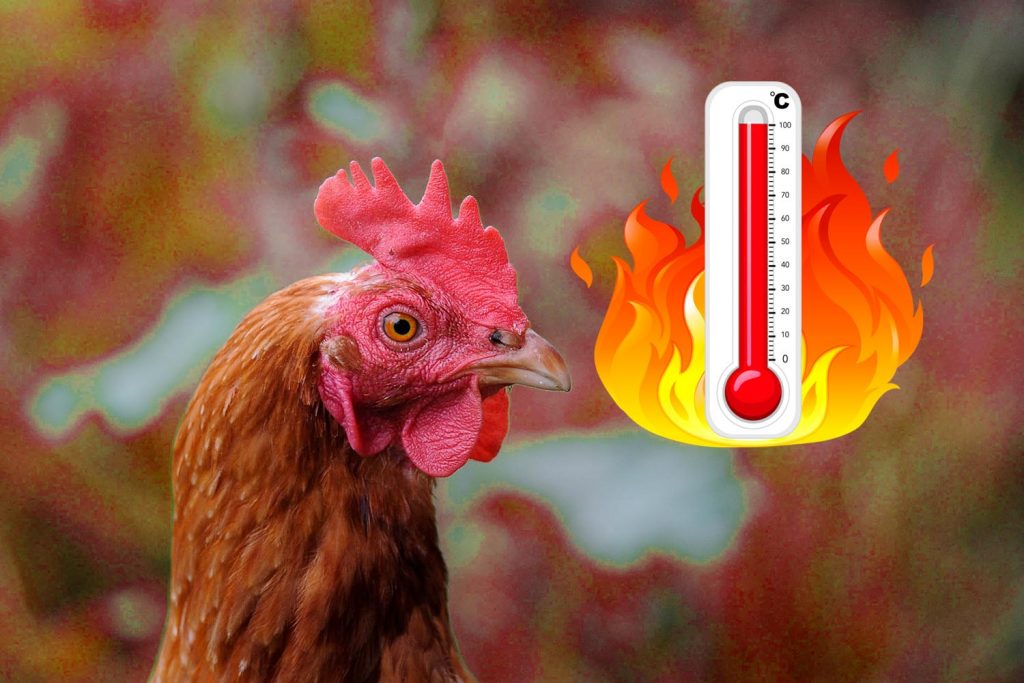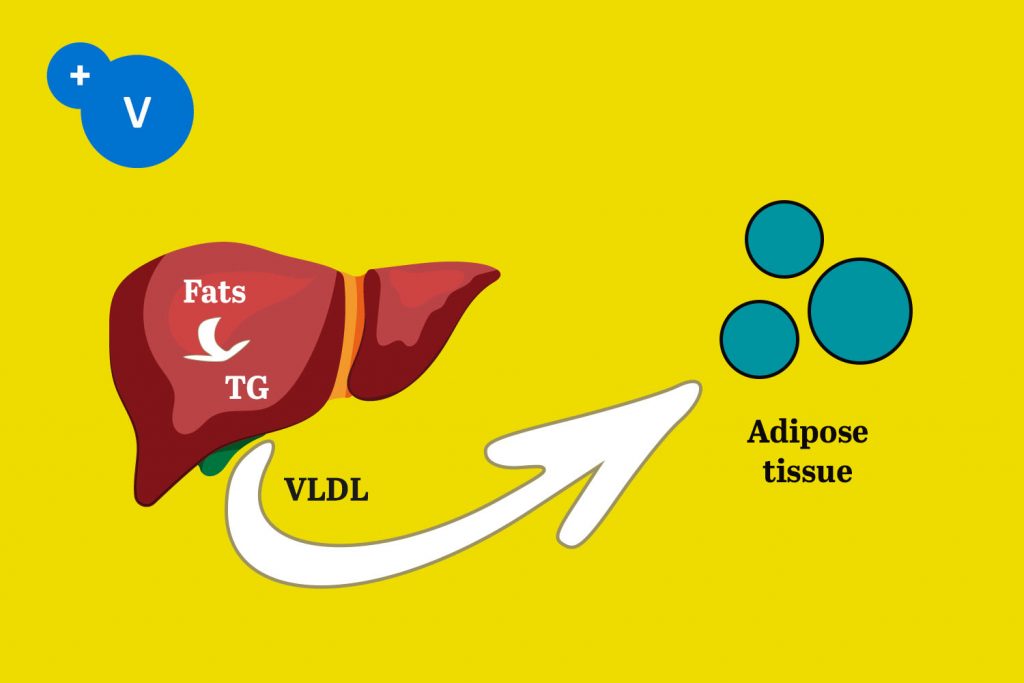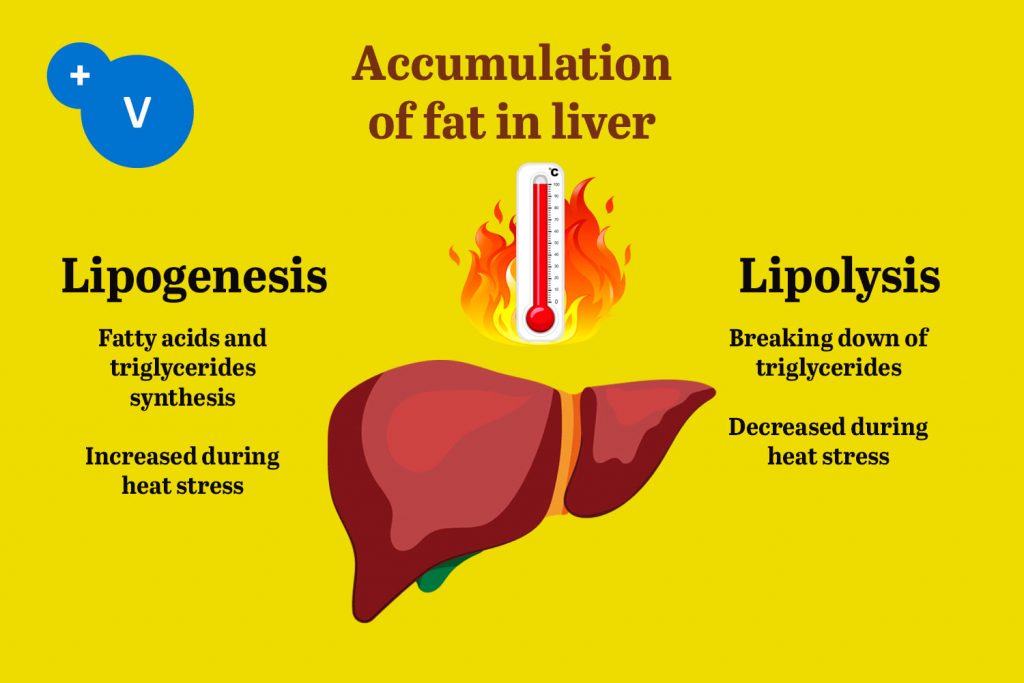02 Jun Heat stress and fatty liver hemorrhagic syndrome in poultry

The liver is a key organ for the health and productivity of poultry and plays a significant part in the digestion, metabolism and utilization of nutrients.
The liver is involved in the metabolism of fats, carbohydrates and proteins; it is the main storage site for fat-soluble vitamins (A, D, E and K), the water-soluble vitamin B12, glycogen, iron and copper; it is involved in the activation of vitamin D; plays a major role in the detoxification of microbial and chemical toxins; provides important circulatory proteins such as albumin and clotting factors; and secretes bile for the digestion of fats.
The liver and fat metabolism in poultry
In birds, unlike mammals, fat synthesis occurs mainly in the liver and the adipose tissues distributed through the body serve only to store fats.
Once synthetized in the liver, fats are transported by very low density lipoproteins (VLDL) to the adipose tissues in the form of plasma triglycerides (TG). Whenever the synthesis of fat in the liver increases, the transport of TG by VLDL to the adipose tissues surges, but when the production of VLDL is no longer sufficient to transport all the TG synthesized by the liver, the leftover lipids accumulate and result in hepatic steatosis or fatty liver disease.

Fatty Liver Disease
Fatty liver disease, also called fatty liver syndrome, fatty liver hemorrhagic syndrome, hepatic steatosis and hepatic lipidosis, is a fairly common disease found mainly in laying chicken, ducks, geese and turkeys. The liver of the affected birds accumulates fat, killing the hepatocytes (liver cells) and replacing them with scar tissue.
Unspecific signs include reduced appetite, abnormal feather color, lethargy, difficulties in breathing, pale combs, greenish or yellowish diarrhea due to excess bilirubin or biliverdin, and death. In laying and breeding hens, the laying rate drops, skeletal problems appear and eggshells become fragile due to alterations in the calcium metabolism.
Specific signs include an enlarged or distended abdomen due to the abnormal size of the liver, to secondary ascites or to fat accumulation. More than 20% of the animals are overweight.
On necropsy, the liver is enlarged, engorged with fat, friable and hemorrhagic. The number of haemorrhages found in the liver help to determine the severity of the disease, through the “fatty liver syndrome score” (from 1, no haemorrhage to 5, more than 25 haemorrhages).
The liver may be also pale, greasy and soft, but paleness is not a specific sign of the disease.
Heat stress and fatty liver disease
The incidence of fatty liver disease increases during the hot season. Experimentally, it has been demonstrated that broilers exposed to heat stress for two weeks show a higher concentration of triglycerides and enzymes related to lipid synthesis in their livers and that after three weeks their liver cells suffer from fatty degeneration.
Nutritional factors associated to fatty liver disease in heat stressed birds
High environmental temperatures, together with the lethargy produced by heat stress, reduce the energy requirements of the animals. The energy left over from what the bird has consumed through the diet is transformed into fats in the liver, where they accumulate and start the fatty liver disease.
As we discussed above, fats are transported to adipose tissues located to other parts of the body, in example the abdomen. The deposit of abdominal fat worsens the negative effects of heat stress, because it interferes with normal breathing and cooling.
Metabolic factors associated to fatty liver disease in heat stressed birds
There is evidence that heat stress produces a severe unbalance in the metabolism of the liver, including increased synthesis of glycogen, glucose, antioxidants such as glutathione, damage to the membranes of the hepatocytes, and a slower cell regeneration cycle.
When it comes to lipid metabolism in the liver, heat stress induces lipogenesis (synthesis of lipids) and inhibits lipolysis (breaking down of fats), leading to accumulation of fats. The metabolic pathways through which these disorders occur are still under investigation, but, in example:
- It has been suggested that the induction of lipogenesis happens through the activation of the liver X receptor (LXR) pathway, a receptor involved in the regulation of cholesterol, fats and glucose.
- It has been hypothesized that the neuropeptide orexin, involved in the regulation of appetite and in the break down of fats, is less expressed in animals affected by heat stress.

Prevention of fatty liver disease during periods of heat stress with certain nutrients and phytogenics
Vitamin E to enhance general liver health
Vitamin E is one of the most potent antioxidants in nature. It plays a key role in neutralizing free radicals or reactive oxygen species (ROS), as we discussed in this post.
The biological activity of vitamin E is not limited to its antioxidant properties: it is involved in the regulation of the following processes: inflammatory response, gene expression, certain enzymes, cellular signaling, and cell proliferation.
During fatty liver disease, the administration of vitamin E reduces the deposits of fats in the hepatocytes, ameliorates inflammation and fibrosis and activates certain beneficial metabolic processes in the liver.
Our products PhytoMax© and PlusBreathe© contain vitamin E.
Selenium and zinc
Birds with zinc and/or selenium deficiencies are more susceptible to fatty liver disease.
On the other hand, the administration of zinc and selenium helps to prevent the onset of the hepatic steatosis and to reduce the damaging effects once the animals are already affected by the disease.
Our product PhytoMax© contains organic zinc and inorganic selenium.
Essential oils and other phytogenics that enhance liver function
Certain essential oils, plant extracts and purified compounds of plant origin have liver-protective activity, through several possible mechanisms of action:
- Show antioxidant activity, promoting the natural antioxidant metabolic pathways of the liver and preventing oxidation of lipids.
- Facilitate the elimination of toxins and other harmful substances out from kidney and liver, which is very useful in long live birds because they are frequently exposed to mycotoxins, pharmaceutical products, heavy metals, dioxins and other toxins.
- Reduce the accumulation of fats in the hepatocytes
- Stimulate the secretion of bile, improving feed digestion.
- Possess antinflammatory activity
- Prevent the death of the hepatocytes
Our product PhytoMax© contains essential oils and phytochemicals of natural origin that enhance liver function.
Essential oils that relieve heat stress
During episodes of heat stress, certain essential oils, such as those contained in PlusBreathe©, are useful through two mechanisms of action:
- Stimulate the cold receptors of the oral and nasal mucosa, giving the animals a very pleasant sensation of ‘freshness’.
- Thanks to their powerful antioxidant properties, fight the oxidative stress associated with high temperatures.
When these essential oils are given through drinking water or sprayed in the environment of the farm, feed intake recovers, productivity increases, mortality drops, and behavior related to heat stress is ameliorated.
Animals are more active and consume more energy, preventing the fatty liver disease associated to nutritional factors.
Products of choice
PhytoMax© is a combination of vitamins, chelated calcium, microminerals and essential oils to be given through drinking water. It is intended for layers and breeders to:
- Maintain the levels of calcium and magnesium needed for optimal egg production.
- Reinforce skeletal health.
- Prevent cage fatigue.
- Stimulate the hepatic metabolism and the immune system.
- Improve the quality of the egg and the health of day-old chicks.
- Avoid the drop of the laying rate produced by stress (management, vaccines, hot weather, etc…)
- At the start of the laying period, to boost productivity.
- Prolong the productive life of the hen.
PlusBind© is a mixture of carefully selected silicates intended for the prevention of diseases and productivity losses related to the presence of all types of mycotoxins. It is indicated in poultry, pigs, aquaculture and ruminants.
The silicates present in PlusBind© have a highly expandable molecular structure. This characteristic gives the product a wide surface available for the adsorption of mycotoxins and therefore allows a high effectiveness at lower doses (0.5-1 kg per ton of feed).
PlusBreathe© contains essential oils with natural antiseptic, antioxidant, expectorant and mucolytic activity. It has a refreshing taste.
It is indicated to improve the functioning of the respiratory system and to mitigate heat stress in birds, ruminants, pigs and rabbits of all ages. It can also be nebulized in the farm environment.

Certain health statements may not be applicable in your region.

